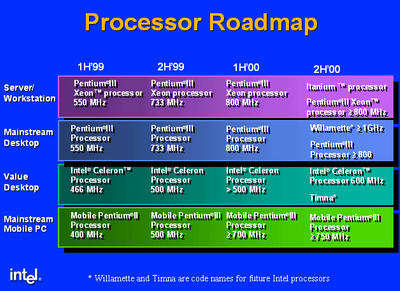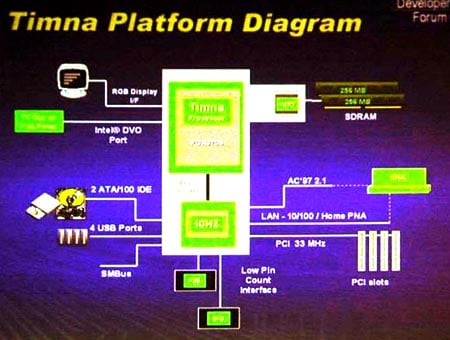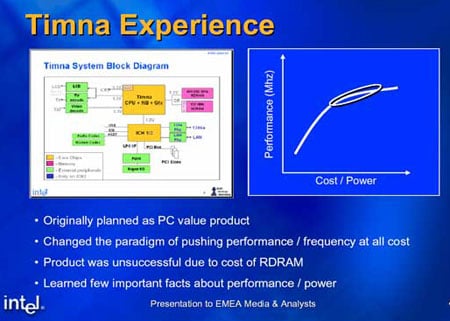Original URL: https://www.theregister.com/2007/02/06/forgotten_tech_intel_timna/
'Timna' - Intel's first system-on-a-chip
Before 'Tolapai', before 'Banias'...
Posted in Personal Tech, 6th February 2007 13:09 GMT
Forgotten Tech With Intel's 'Tolapai' system-on-a-chip (SoC) part making headlines this week, it's worth remembering this embedded part isn't Intel's first highly-integrated processor. Ironically, the core Tolapai is said to be based on, the Pentium M, may have been instrumental in the demise of 'Timna', the chip giant's first major SoC project.
Timna emerged in March 1999 when 3D graphics chip specialist S3 - later acquired by VIA but then independent - hinted it was working on a SoC part with Intel. The chip would contain S3's Savage 4 GPU, the company suggested.

Three months later, the rumour mill was discussing Timna's Pentium II-class processing core, 128KB of L2 cache, integrated South Bridge and Rambus RDRAM memory controller. Not long after, it was said to be clocked at 533-700MHz and be fabbed at 180nm. The chip would be offered in a 370-pin package. A reference motherboard designed for the part was apparently codenamed 'Arago'.
Around this time, a number of chip makers, most notably National Semiconductor were looking to a future of ultra low-cost PCs given away by service providers to encourage World+Dog to start using the internet. Earlier, Intel acquired Chips & Technologies, ostensibly to boost its own SoC expertise, and it's possible Timna was a result of that purchase. The chip itself was developed by Intel's design team in Haifa, Israel.
Certainly, Intel itself indicated the part would be aimed at budget desktops, though the chip maker may well have had its eye on the so-called 'internet appliance' device no small number of analysts were touting at the time, all eager to forecast how the masses would be connecting to the net in the very near future. On such hot air was the dotcom bubble inflated...
That didn't stop Samsung saying early in 2000 that it was planning a sub-$200 PC which, while not explicitly stated as being based on Timna, was nonetheless said by the company to have a feature set like that of the Intel SoC. Samsung was eyeing a Christmas 2001 launch, well over a year after the mid-2000 launch date being associated with Timna at the time. By the time Samsung's system was due, the internet bubble had burst.
In the Spring of 2000, Intel confirmed it was working on a range of SoCs, of which Timna was merely the low-end version. Timna was demo'd for the first time in public. At the time Intel called it a "smart integration product". Pat Gelsinger, then the chip giant's CTO, said the SoC's memory controller would initially use SDRAM, with RDRAM support coming in 2001. This would, he said, begin "the transition of RDRAM into the value segment".

By now, Timna was being stated on leaked roadmaps to debut at 666MHz. A 700MHz version would also ship later in 2000. At the Computex show, held in Taipei in June, we even saw some Timna-oriented motherboards. That said, whisperings around the show alleged Timna was being delayed, to Q1 2001. There were problems, it was claimed, with the SoC's memory hub technology. It was inefficient, and Intel needed more time to fix it.
Then, in October 2000, Intel confirmed it had knocked Timna on the head. The Memory Translator Hub, used to connect the chip to SDRAM rather than RDRAM - as Gelsinger had promised the previous Spring - had proved to be a flawed design, it was alleged. With SDRAM appearing more viable in the longer term than RDRAM, especially at the low system price-points Timna was to have targeted, Intel may have tried to shoehorn SDRAM support onto the SoC, with disastrous results.

And in any case, Intel was eyeing up the possibilities a dedicated notebook processor would bring it. Why pitch for a business predicated on low-cost - and therefore low-margin - PCs, when it could target the high-margin but rapidly expanding laptop market?
Enter the development effort that would produce 'Banias', Intel's first notebook-specific processor and the basis for its Centrino platform. Both were launched in Spring 2003, but early details began to appear in early 2001, exactly the timeframe the delayed Timna was due to have appeared.
More Forgotten Tech...
• 15 years ago: the first mass-produced GSM phone
• Compact Disc: 25 years old today
• From 1981: the World's first UMPC
• The IBM ThinkPad: 15 years old today
• Apple's first handheld: the Newton MessagePad
• Atari's Portfolio: the world's first palmtop
• BeOS: the Mac OS X might-have-been
• Sony's first Mylo